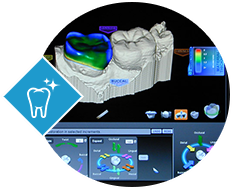
Introduction
It seems like each and every week technology changes the way we do things, and dentistry is no different. CAD / CAM technology and digital impressions allow for greater accuracy and communication, along with new opportunities for dentists, labs and most importantly, the patients.
CAD / CAM is an acronym that means computer-aided design/computer-aided manufacturing. CAD / CAM technology has been used in the manufacturing industry for many years. Today, CAD / CAM technology is used in dentistry to help dentists and dental lab technicians fabricate precise shapes and sizes for dental restorations, including inlays, onlays, crowns, and bridges. Dentists use CAD / CAM technology to provide their patients with durable, well-fitted single and multiple tooth restorations in a more efficient manner than traditional lab-fabricated restorations.
Another advantage of CAD / CAM technology is that it can allow a typical two-visit tooth restoration to be accomplished in one visit, provided that the dentist has the technology in the office (chairside CAD / CAM).
Dentists and dental lab technicians use CAD / CAM technology to design the anatomical features, size and shape of a tooth restoration on a computer. The CAD / CAM computer screen displays a 3-D custom image of your teeth and gums, allowing your dentist to use a cursor to draw the precise design of the tooth restoration. The CAD / CAM machine fabricates the restoration through a milling chamber that crafts the tooth-like ceramic material into a precise replica of the drawing.

Advantages of CAD / CAM Technology
One of the advantages of CAD / CAM technology is that, provided the CAD / CAM equipment is located in the dental office, your dentist does not need to create a molded impression of your teeth. Secondly, there may be no need for a temporary restoration or a return visit to the office for a permanent restoration. If the technology is located at a dental lab rather than the dental office, then a two-visit restoration is necessary.
CAD / CAM technology cannot replace the dentist or dental lab technician who must be accurate in creating the initial tooth preparation and impression. For example, a high level of skill is crucial in fabricating and fitting crowns. An ill-fitted crown can leave space between the teeth or between the tooth preparation and the crown, which may be problematic in two ways:
- Increased risk of infection or disease because debris may lodge in the open space.
- Increased risk of teeth shifting because of the open space.
Previously, it has been difficult to offer high levels of tooth restoration strength without using metals, such as in an amalgam dental filling or gold restoration. However, today's porcelain ceramics work very well in the milling chamber, providing strength, durability, and a high esthetic value. Furthermore, today's materials such as zirconia may be more "fracture resistant" than those of the past. Although CAD / CAM is an exciting technology, it is not necessarily applicable to all procedures requiring porcelain.
Of CAD /CAM crowns, bridges, veneers, inlay onlay, some of the popular brands which we provide to our patients and get them fabricated from the top laboratories of India, U.S.A. and Sweden are :
- Procera ( Nobel Biocare ) www.nobelbiocare.com
- Everest ( Kavo Dental Corporation ) www.kavousa.com
- Cerec ( Sirona ) www.cereconline.com/cerec
- Orion ( Zerkonindia ) www.zerkonindia.com
- Lava ( 3M ) www.3m.com
To know the details of the products given above kindly click the link given with each product.


"Perfection & patient satisfaction is what we care about"
Contact us now to schedule an appointment.

